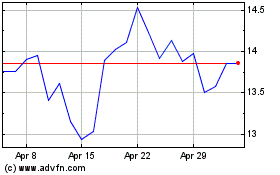NTSB Urges Updates of Engine-Inspection Procedures and Passenger Evacuation Rules For U.S. Airlines
January 30 2018 - 9:06PM
Dow Jones News
By Andy Pasztor
U.S. air-accident investigators have called for upgraded
engine-inspection practices and better-coordinated procedures for
passenger evacuations, in their final report about a fire that
badly damaged an American Airlines Group Inc. jet on a Chicago
runway two years ago.
The findings and recommendations released by the National
Transportation Safety Board on Tuesday stem from an October 2016
accident in which a rare manufacturing defect caused part of the
right engine on a Boeing Co. 767 bound for Miami to rupture
violently late in the takeoff roll. Metal parts flew as far as
3,000 feet, a fuel leak caused a massive fire under the right wing
and all 161 passengers used emergency slides to leave the jet.
There were no fatalities, but the NTSB issued industrywide
recommendations for modernized engine inspections and stepped-up
airline crew training to ensure safer emergency evacuations.
According to the NTSB, U.S. regulators haven't updated guidance
on conducting emergency evacuations for three decades, despite
several high-profile examples of problems getting passengers off
airliners in just the past few years.
Investigators concluded that a rare manufacturing flaw dating
back to the late 1990s -- and likely undetectable through recent
years -- created microscopic cracks in the high-energy internal
disc that eventually led to the accident at O'Hare International
Airport. General Electric Co. manufactured the engines.
Even with significant safety advances in engines and overall
airline performance over the last few decades, "there's still
improvements that can be made," said Robert Sumwalt, the safety
board's chairman. Inspection methods "that can fail to uncover a
defect in a safety critical component of an airliner," he said,
"need a closer look.:
Regarding the crew's response, the NTSB concluded that the
pilots, after hearing a loud bang, acted appropriately to halt the
takeoff and shut down the damaged engine. But the report was
critical of the level of cooperation between the cockpit crew and
flight attendants.
Investigators, among other things, found that flight attendants
hadn't received adequate training on systems to communicate with
the cockpit or passengers. Two attendants told the safety board
they couldn't operate the intercoms to contact the pilots, as smoke
billowed inside the cabin and passengers disregarded instructions
by climbing over seats and insisting on grabbing carry-on bags.
With one of the wide-body jet's engines still running as the
evacuation began, a passenger suffered a serious injury as he was
hit by jet blast. The pilots told investigators the only emergency
engine shut-off checklist they had didn't call for immediately
turning off the remaining engine.
Modern jet turbines are designed to prevent broken parts from
being spewed outside the engine cover. But violent disintegration
of some internal parts has dogged certain models of GE's CF6-80
model engines since 2000, prompting a series of stepped-up safety
actions by the manufacturer and the Federal Aviation
Administration.
An FAA spokeswoman didn't have any immediate comment on the
nonbinding safety recommendations.
American, which has revamped flight attendant training, told
investigators the cabin crew took appropriate steps to initiate the
evacuation despite communication difficulties.
Write to Andy Pasztor at andy.pasztor@wsj.com
(END) Dow Jones Newswires
January 30, 2018 20:51 ET (01:51 GMT)
Copyright (c) 2018 Dow Jones & Company, Inc.
American Airlines (NASDAQ:AAL)
Historical Stock Chart
From Mar 2024 to Apr 2024

American Airlines (NASDAQ:AAL)
Historical Stock Chart
From Apr 2023 to Apr 2024
